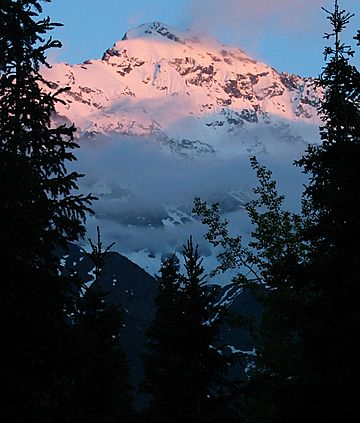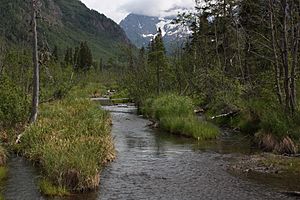Eagle Peak (Alaska) facts for kids
Quick facts for kids Eagle Peak |
|
|---|---|

The Northern face of Eagle Peak remains covered in snow throughout early summer
|
|
| Highest point | |
| Elevation | 6,955 ft (2,120 m) |
| Geography | |
| Parent range | Chugach Mountains |
| Climbing | |
| First ascent | 1966; B. Babcock, B. Hauser |
| Easiest route | The southern face and southeast ridges are the most popular, and probably safest, routes. |
Eagle Peak is a tall mountain in Alaska, standing about 6,955-foot (2,120 m) high. It is located in Chugach State Park near Anchorage Municipality. The mountain gets its name from the nearby Eagle River. On clear days, you can see Eagle Peak from the city of Anchorage.
Contents
Where is Eagle Peak Located?
Eagle Peak is found at the very top of the South Fork Eagle River Valley. It sits east of downtown Anchorage. This mountain is the highest point along a long ridge. Other peaks on this ridge include Flute Peak (6,610 feet) and Hurdygurdy Mountain (5,965 feet).
Eagle Peak stands tall above Eagle Lake, Flute Glacier, and the Eagle River Valley. It is one of several impressive peaks in the area that are over 6,000 feet high.
What Does Eagle Peak Look Like?
On its eastern side, Eagle Peak starts at about 700 feet above sea level. From there, it climbs to its 6,955-foot summit in just over a mile and a half. From above, the mountain looks like a three-sided pyramid. It has ridges connecting from its northwest and south sides.
All sides of Eagle Peak have many cliffs. A very noticeable series of cliffs on the northern side rises almost 3,000 feet straight up!
What is the Land Like on Eagle Peak?
Starting at about 1,000 feet up, Eagle Peak becomes an alpine zone. This means it's a high-altitude area with very little plant life. You'll find different kinds of lichens growing there. There's also a lot of snow, including snowfields that stay all year round. Much of the mountain is made of bare rock, which can sometimes be loose.
What Animals Live on Eagle Peak?
Like many mountains in Alaska, Eagle Peak is home to various alpine animals. You might see ptarmigan, Dahl sheep, and mountain goats. Even though there isn't much plant life, many types of insects live at high elevations throughout Alaska. If you look up, you might spot a hawk or an eagle flying overhead.
Images for kids






